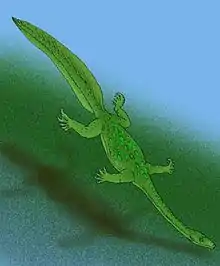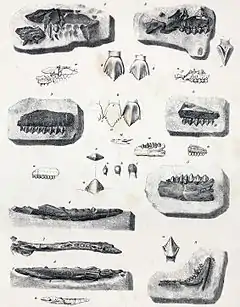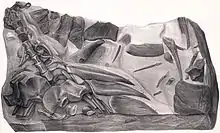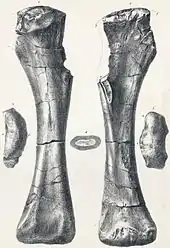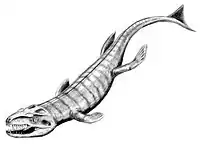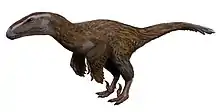Berriasian
In the geological timescale, the Berriasian is an age/stage of the Early/Lower Cretaceous. It is the oldest subdivision in the entire Cretaceous. It has been taken to span the time between 145.0 ± 4.0 Ma and 139.8 ± 3.0 Ma (million years ago). The Berriasian succeeds the Tithonian (part of the Jurassic) and precedes the Valanginian.
| Berriasian | |
|---|---|
| ~145.0 – ~139.8 Ma | |
| Chronology | |
Key events in the Cretaceous -140 — – -130 — – -120 — – -110 — – -100 — – -90 — – -80 — – -70 — – An approximate timescale of key Cretaceous events. Axis scale: millions of years ago. | |
| Etymology | |
| Name formality | Formal |
| Usage information | |
| Celestial body | Earth |
| Regional usage | Global (ICS) |
| Time scale(s) used | ICS Time Scale |
| Definition | |
| Chronological unit | Age |
| Stratigraphic unit | Stage |
| Time span formality | Formal |
| Lower boundary definition | Undefined |
| Lower boundary definition candidates |
|
| Lower boundary GSSP candidate section(s) | None |
| Upper boundary definition | Undefined |
| Upper boundary definition candidates | FAD of the Calpionellid Calpionellites darderi |
| Upper boundary GSSP candidate section(s) |
|
Stratigraphic definition
The Berriasian Stage was introduced in scientific literature by Henri Coquand in 1869. It is named after the village of Berrias in the Ardèche department of France. The largely non-marine English Purbeck Formation is in part of Berriasian age. In fact, the first rocks to be described of this age were the beds of the English Purbeck Formation, named as the Purbeckian by Alexandre Brongniart in 1829 following description by Henry De la Beche, William Buckland, Thomas Webster and William Henry Fitton.
The base of the Berriasian, which is also the base of the Cretaceous system, has traditionally been placed at the first appearance of fossils of the ammonite species Berriasella jacobi. But this is a species that has a stratigraphically problematic and geographically limited distribution. A global reference profile (a GSSP) for the Berriasian has been under active consideration by the International Subcommission on Cretaceous Stratigraphy (ISCS) of IUGS. A range of contender GSSP localities has been studied in detail by the ISCS's Berriasian Working Group including localities as far apart as Mexico, Ukraine, Tunisia, Iraq and the Russian Far East. Several markers have been employed to refine correlations and to work towards defining a base for the Berriasian Stage. These include calcareous nannofossils, such as Nannoconus, calpionellids, ammonites, palynological data and magnetostratigraphy, notably magnetozone M19n. The calibration of these markers, especially Nannoconus steinmannii minor, N. kamptneri minor, and Calpionella alpina, within precisely fixed magnetozones give greater precision in trying to identify the best position for a boundary. In June 2016, the Berriasian Working Group voted to adopt Calpionella alpina as the primary marker for the base of the Berriasian Stage. In May 2019, a GSSP for the Berriasian was selected by a vote of the Berriasian WG of the ISCS: it is the profile of Tré Maroua in the Vocontian Basin (Hautes Alpes, France)
In the western part of the ocean of Tethys, the Berriasian consists of four ammonite biozones, from top to bottom (latest to earliest):
- Thurmanniceras otopeta
- Subthurmannia boissieri
- Tirnovella occitanica
- Berriasella jacobi/Pseudosubplanites grandis
The top of the Berriasian stage is defined by the base of the Valanginian, which is fixed at the first appearance of calpionellid species Calpionellites darderi. This is just a little below the first appearance of the ammonite species Thurmanniceras pertransiens.
Regional terms used to refer to time periods equivalent to the Berriasian include the Ryazanian in Europe.
Palaeontology
Birds (avian theropods)
| Birds of the Berriasian | ||||
|---|---|---|---|---|
| Taxa | Presence | Location | Description | Images |
Choristodera
| Non-Thalattosuchian Crocodylomorphs of the Berriasian | ||||
|---|---|---|---|---|
| Taxa | Presence | Location | Description | Images |
| Shokawa, Gifu Prefecture, Japan | A choristoderan diapsid reptile closely resembling and closely related to the smaller choristoderan, Hyphalosaurus. |
| ||
Crocodylomorphs (Non-Thalattosuchian)
| Non-Thalattosuchian Crocodylomorphs of the Berriasian | ||||
|---|---|---|---|---|
| Taxa | Presence | Location | Description | Images |
| England and Spain | A species of goniopholidid mesoeucrocodylian. Was referred to as a species of Goniopholis by some authors. | |||
Mammalia
| Mammals of the Berriasian | ||||
|---|---|---|---|---|
| Taxa | Presence | Location | Description | Images |
| Durlston Bay, Dorset, England | ||||
| Lulworth Formation, England | ||||
| Durlston Bay, Dorset, England; Spain | ||||
| Portugal | ||||
| Durlston Bay, Dorset, England | ||||
| Portugal | ||||
†Ornithischians
| Ornithischians of the Berriasian | ||||
|---|---|---|---|---|
| Taxa | Presence | Location | Description | Images |
| Swanage, England | A bipedal herbivore, it was around 0.6 meters (2 ft) long. Unlike most ornithischians, Echinodon had one or two caniniform teeth in each maxilla. |
| ||
| Kirkwood Formation, Cape Province, South Africa | A 4 meters long, 1.8 meters high stegosaurid with a skull similar to Kentrosaurus | |||
| England | A dryosaurid | |||
†Pterosaurs
| Pterosaurs of the Berriasian | ||||
|---|---|---|---|---|
| Taxa | Presence | Location | Description | Images |
| Berriasian-Albian | UK |
| ||
| Romania | ||||
| Purbeck Limestone, Dorset, England | ||||
†Sauropods
| Sauropods of the Berriasian | ||||
|---|---|---|---|---|
| Taxa | Presence | Location | Description | Images |
| South Africa |
| |||
†Thalattosuchia
| †Thalattosuchians of the Berriasian | ||||
|---|---|---|---|---|
| Taxa | Presence | Location | Description | Images |
| From Kimmeridgian to Valanginian |
| |||
| From Tithonian to Valanginian | ||||
| From Kimmeridgian to Hauterivian | Austria, England, Germany, Portugal and Switzerland | |||
†Theropods (non-avian)
| †Non-avian theropods of the Berriasian | ||||
|---|---|---|---|---|
| Taxa | Presence | Location | Description | Images |
|
| ||||
|
Berriasian-Barremian |
Sao Khua Formation, Thailand |
|||
References
Notes
- Dating uncertain.
- Only known from this stage.
Literature
- Gradstein, F.M.; Ogg, J.G. & Smith, A.G.; (2004): A Geologic Time Scale 2004, Cambridge University Press.
External links
- GeoWhen Database - Berriasian
- Jurassic-Cretaceous timescale, at the website of the subcommission for stratigraphic information of the ICS
- Stratigraphic chart of the Lower Cretaceous, at the website of Norges Network of offshore records of geology and stratigraphy
